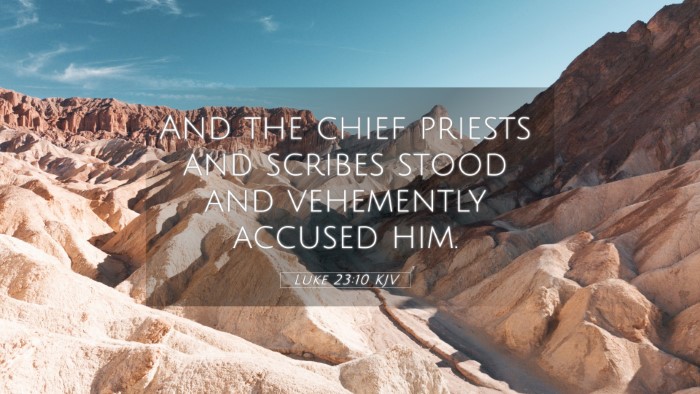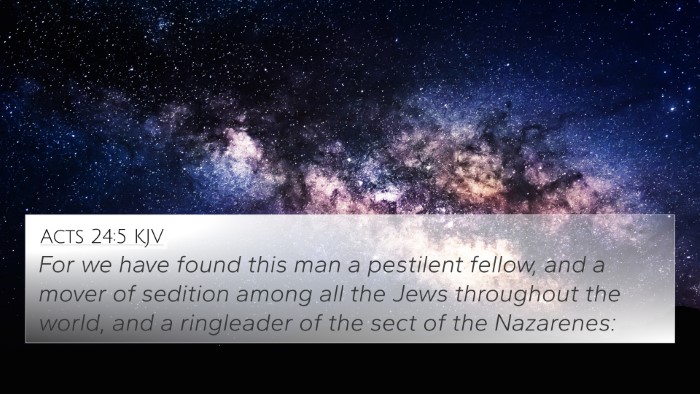Understanding Luke 23:10
Verse Context:
Luke 23:10 states, "And the chief priests and scribes stood and vehemently accused him." This verse is situated in the narrative of Jesus' trial before Pilate, wherein He faces accusations from the religious leaders. The tensions surrounding His ministry culminate in this moment of legal and political conflict.
Meaning and Interpretation
Historical Context:
This verse illustrates the intense scrutiny and hostility Jesus faced from the religious elite of His day. The involvement of the chief priests and scribes reflects a culmination of their opposition to Jesus' teachings, actions, and claims of authority.
Matthew Henry's Commentary:
Henry notes the fervor with which the accusers brought their charges against Jesus, emphasizing that such vehement accusations reveal their deep-seated animosity. The religious leaders, feeling threatened by Jesus' influence and authority, engaged in a campaign to discredit Him at any cost.
Albert Barnes' Commentary:
Barnes highlights the irony that those who should have recognized and honored Jesus as the Messiah instead became His greatest adversaries. Their vehement accusations not only signify a betrayal of their roles but also underscore the fulfillment of prophecy regarding the rejection of the Messiah.
Adam Clarke's Commentary:
Clarke provides insight into the nature of the accusations, detailing how they stemmed from a place of fear and jealousy. He illustrates that the accusations were more about political power than genuine concern for justice, revealing the moral bankruptcy of the accusers.
Thematic Connections
Understanding this verse can be enriched by cross-referencing several related biblical passages:
- Matthew 26:59-61 - Provides details on the false testimonies presented against Jesus.
- Mark 14:55-57 - Highlights the failure of the religious leaders to find credible evidence against Him.
- John 18:30 - Shows the disdain of the Jews toward Roman authority as they insist on punishing Jesus.
- Isaiah 53:3 - Prophetic insight into the suffering servant who would be rejected by men.
- Acts 3:14 - Peter's reference to how the people rejected the Holy One and just, emphasizing this theme of rejection.
- Hebrews 4:15 - Speaks to Jesus' understanding of human weakness and betrayal.
- 1 Peter 2:23 - Describes how Jesus, when reviled, did not retaliate, affirming His innocence amidst accusations.
Cross-Referencing Biblical Texts
This verse serves as a foundation for understanding the interconnected nature of biblical narratives. The theme of unjust accusation resonates through various scripture passages, providing a rich tapestry of inter-Biblical dialogue:
Exploring Connections Between Bible Verses:
- A comparative study of Matthew 27:12-14, where Jesus remains silent in the face of accusations, contrasting the hostility of His accusers.
- Linking Luke 19:47-48, which showcases the ongoing conflict between Christ and the religious leaders, setting the stage for this moment of intense accusation.
- Analyzing John 5:16 and the previous instances of opposition from the Jews, clarifying the backdrop of animosity leading to stronger actions against Jesus.
- Investigating the prophetic allusions in Psalm 38:20, which speaks of being repaid with evil for good, echoing the sentiments revealed in Luke 23:10.
Tools for Bible Cross-Referencing
For deeper exploration of the themes found in Luke 23:10, consider utilizing tools like Bible concordances, cross-reference guides, and cross-referencing methods for Bible study:
- Bible Concordance: A resource to track themes and words across scripture.
- Cross-Reference Systems: Identifying how scripture relates to scripture enhances understanding.
- Bible Study Resources: Utilize tools designed to guide through complex biblical themes and connections.
Conclusion
Understanding Luke 23:10 involves recognizing the intense opposition Jesus faced, contextualizing it within both its immediate narrative and the broader biblical story. Through systematic cross-referencing and thematic exploration, one can appreciate the depth of this pivotal moment. The tools available for study are crucial in unveiling the layers of meaning embedded in scripture.







